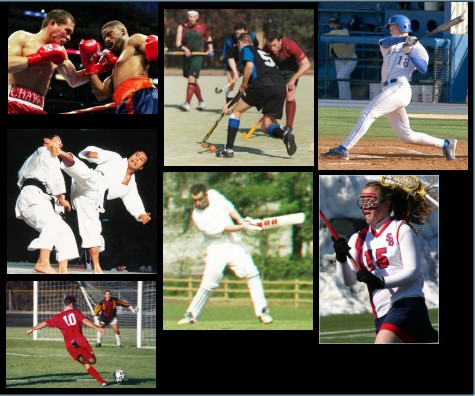Sports Recovery

photo from wikipidia.com used under the creative commons license ( https://en.wikipedia.org/wiki/File:Sports-dress-codes.jpg )
“Break a leg” isn’t always the best advice! As the sports season picks up its intensity this spring, many athletes will have questions on how to best take care of their bodies. Mrs. Bethany, our resident Pyshical Trainer expressed how important it is to take proper care of your body during a sports season, “The more you spend time doing what you need to such as strength training, the less likely you are too spend wime in my room all season!”
All types of sports can have varying effects on bodies ranging from soreness to rashes to torn ligaments. Sports injuries can cause long-lasting damage if the athlete does not take care of his or her body before and after each workout. Most injuries athletes endure are temporary and can be corrected by physical therapy and rest.
There is more to making sure your body is healthy and happy than touching your toes every now and then before you go for a run. Stretching is, of course, very important to remember before you hit the trail, court, field or track because it loosens your muscles, allowing for a larger range of movement, increased flexibility, and greater muscle control.
There are several different types of stretching: dynamic stretching, passive (or relaxed) stretching, static stretching, etc. Each has its purpose; dynamic stretching improves dynamic flexibility and is quite useful as part of your warm-up for an active or aerobic workout such as soccer, basketball, swimming, lacrosse, or football. Relaxed stretching is very good for cooling down after a workout and helps reduce post-workout muscle fatigue and soreness. It also can help with old injuries by slowly increasing the range of flexibility back to where it was original.
Static stretching is similar to passive stretching but it increases the flexibly of the muscle passed where you would normally stop increasing your flexibility. Physical trainers can all give specific stretches to athletes to help with a specific area or injury.
Stretching hardly scratches the surface of the massive sports recovery domain. Another way to release tension pent up in your muscles is referred to as Self -Myofascial release (SMR): the objective is to use implements such as foam rollers, lacrosse balls, frozen water bottles and other specialty items (the stick, Thera cane) etc. in an effort to “massage your muscles.”
Replacing the lost fluids is another given and after a workout, rehydrating yourself with water and a sports drink can work wonders. It can help with your sore joints and acne as well.
Who knew that sleeping and simply relaxing can be beneficial to your health, despite what your mother said. Sleep allows your body the much-needed break it deserves as well as offering you an excuse to put off your homework for another hour. https://www.google.com/url?sa=t&rct=j&q=&esrc=s&source=web&cd=1&ved=0ahUKEwjZo_XIlsDSAhVLw1QKHULyDUAQyCkIHTAA&url=https%3A%2F%2Fwww.youtube.com%2Fwatch%3Fv%3DitAOGRiYRLI&usg=AFQjCNHtHq1NWpO8AW2imj1ounouvofjUQ
Ice baths may make you feel like the arctic has taken a likening to your bathroom and has just announced that it will be staying for another week like the uninvited estranged family member that is somehow related to you. Or perhaps that your bones have been frozen over. Now before you cross them off your list let me say as someone who has extensive knowledge of these coffins of self-inflicted death by freezing, they work wonders. Ice baths help remove inflammation from your joints, muscles and tendons. It destroys that annoying ache in your knee or crack in your back. Thus, ice baths are a necessary evil for high intensity athletes.

Hello! My name is Katlyn Blacksten, or "Kat" to those who know me. The girls Varsity Basketball team is to blame for that because when I first tried out,...


